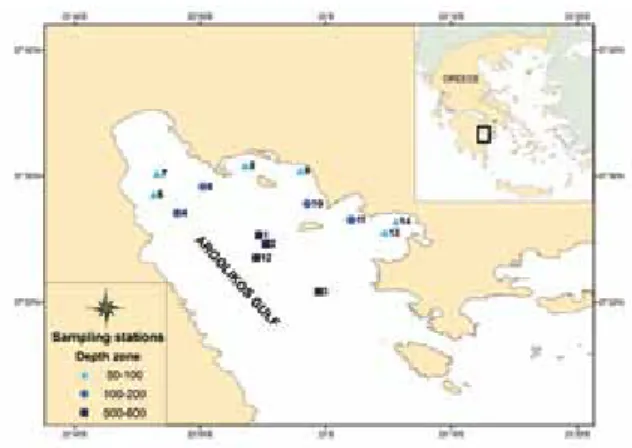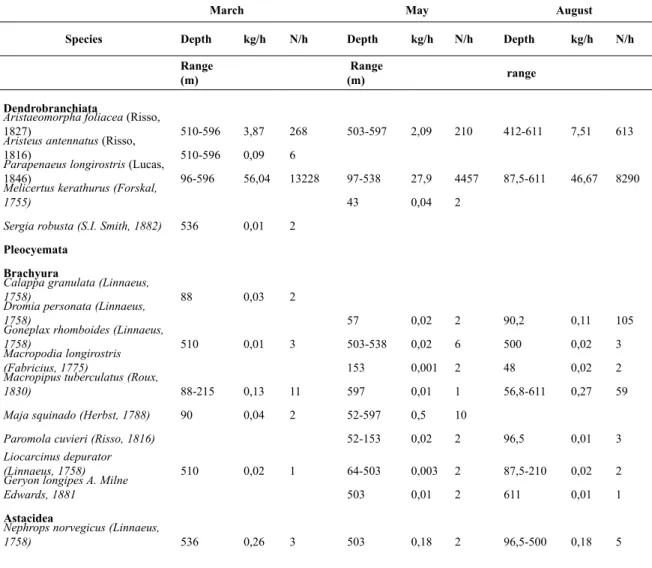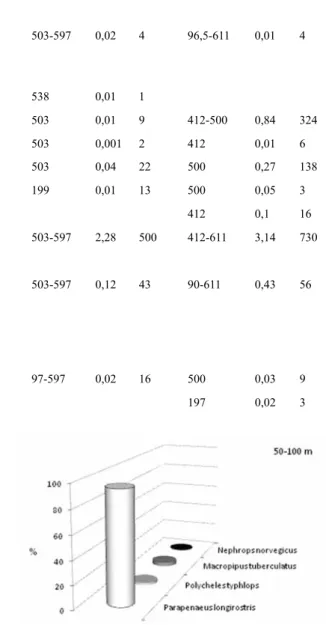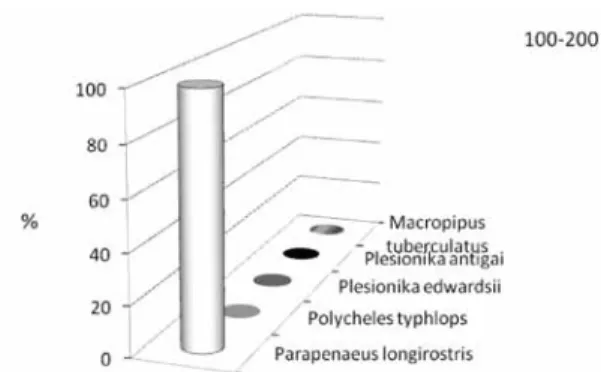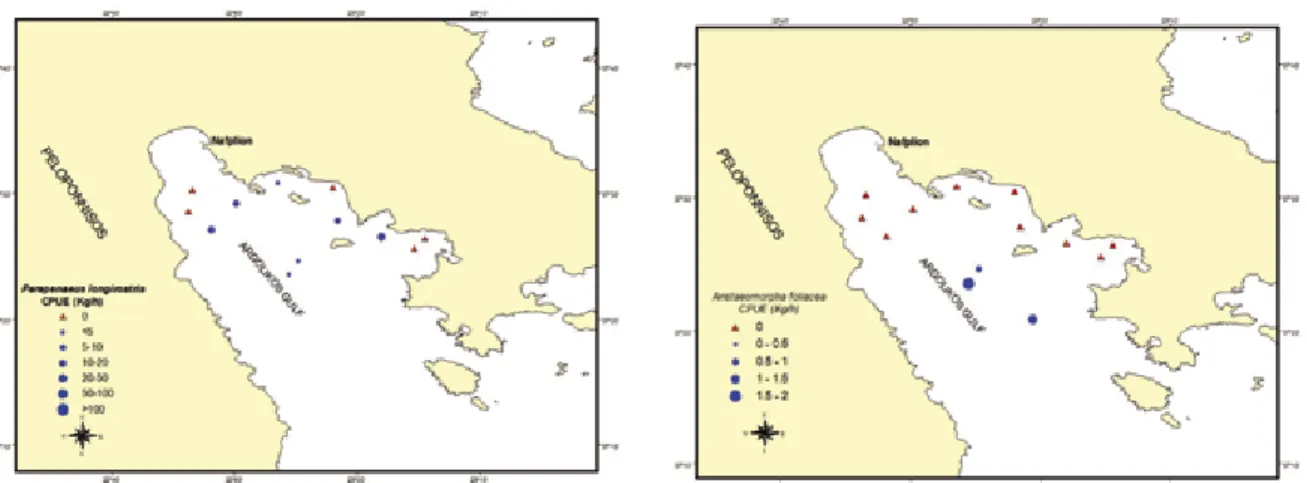Decapod crustacean fauna of the Argolikos Gulf
(Eastern Mediterranean, Central Aegean Sea)
Kostas KAPIRIS*,
Katerina DOGRAMMATZI,
George CHRISTIDIS,
Irida MAINA
and Dimitris KLAOUDATOS
Hellenic Centre for Marine Research, Institute of Marine Biological Resources, 47o km Athens-Sounio, Mavro Lithari P.O. Box 712, 19013, Anavissos, Attica, Greece
*Corresponding author, e-mail: kkapir@hcmr.gr
The study presents the biomass, the abundance and the depth distribution of the decapod crustaceans in Argolikos Gulf (Central Aegean Sea) from data collected in trawl surveys carried out throughout 2008. This work is the first systematic work in this important Greek area and will support the knowledge for understanding the decapods stocks’ fishery in the above area. A total of 28 species of decapod crustaceans was identified from a total of 42 hauls made in three depth zones (50-100 m, 100-200 m, 500-600 m). Among decapods recorded were 6 Dendrobranchiata (5 Penaeoidea, 1 Sergestoidea), 22 Pleocyemata (9 Brachyura, 8 Caridea, 2 Anomura, 1 Palinurid, 1 Astacideum, 1 Stenopodidea). The most abundant commercial species found in both shallower depth zones (50-100 m, 100-200 m ) was Parapenaeus longirostris while in the deepest one (500-600 m) Aristaeomorpha foliacea was the most numerous. Some new depth distribution records for the Eastern Mediterranean were obtained for some few species.
Key words: Crustacea Decapoda, abundance, depth distribution, Aegean Sea, Greece
INTRoDuCTIoN
The Argolikos Gulf is a relatively shallow open gulf located in the central Aegean Sea. Its total surface is 2154,3 km2 corresponding to the 1,63% of the total Greek surface. The total length of the gulf is 54 km and the maximum width is 20 km. The maximum depth of the Argolikos Bay is 820 m in the center, while the depths of over 500 m are usually found from northwest to southeast. The Argolikos Gulf represents almost the 50% of the total gross value of the fishery production of the Pelopon-nese Region. The total fishery production of the Argolikos Gulf, including marine fisheries, lagoons, and aquaculture, is around 8500 t annu-ally and has remained relatively constant in the
past few years (Source: Prefectural Administra-tion of Argolis). The majority of the registered vessels in the area are small (smaller than 12 m) inshore fishing vessels (mainly netters and long-liners); only a very small fraction belong to medium-scale fishery (1,43% purse seines, 1% trawlers) (HCMR, 2008). There are only very
few and scanty scientific data on the biological resource.
The crustacean fishery in Greek waters does not constitute a particular branch of the mul-tispecies Hellenic fishery. The most important commercial species in Greek waters are the Norwegian lobster (Nephrops norvegicus), the penaeid shrimps Parapenaeus longirostris and
Melicertus kerathurus, the palinurid lobster Pal-inurus elephas, the homarid lobster Homarus
gammarus. Apart from these, some other species could be characterized as by-catch such as the portunid crab Liocarcinus depurator, the majid crab Maja sp., the calappoid crab Calappa gran-ulata, the stomatopod Squilla mantis and the squat lobster Munida sp. The most commercial shrimp species in Greek waters of the Aegean Sea are P. longirostris and M. kerathurus, which are the most important in terms of landing and economic value (MYTILINEOU et al., 2001).
Fur-thermore, some shrimps are potentially market-able species such as the deep-water shrimps (Pandalidae, Aristeidae) or are locally impor-tant species, such as the palaemonid shrimp
Palaemon adspersus (KAPIRIS et al., 2007).
According to the last available statistical data of ETANAL (2010), the crustacean landings
from Hellenic waters were 3615,2 t, represent-ing 5,25% of the total landrepresent-ings; while the value is about 35% of the value of total landings (ETANAL data). The total catch of shrimps was the 85% of the crustaceans’ catch, while the rest of the catch consisted of lobsters, spiny-rock lobsters, crabs, sea-spiders and freshwater crus-taceans (FAO data). According to the ELSTAT data (Hellenic Statistical Authority data) the mean annual crustacean catches in Greek waters showed a continuous increase from 175 t (1928-1934) to 1.260 t (1964-1981) and from 3.181 t (1990-2002) to 3330,71 t (2003) and from 4210,40 t (2004) to 5065,02 t (2005-2007) (ELSTAT data).
The main objective of this study was to present the knowledge on the first fishery data and the depth distribution of the decapods crustaceans on the trawlable bottoms of the Argolikos Gulf. The present information will be a useful tool for the definition of the decapod crustaceans biodiversity which is a very signifi-cant assistance for the environmental manage-ment of the Mediterranean basin.
MATERIAl AND METhoDS
This study is a part of the first systematic attempt to detect the fishing resources in the Argolikos Gulf. Data were collected within the framework of the project «Study of the
sustain-ability of fisheries of the Argolikos Gulf» (EP. AL, Meter 4.4.) by trawling at the depth ranging between 58 and 596 m in the months, March, May and August of 2008. The random stratified sampling design was applied using depth for the stratification of the study area. Trawl hauls were performed in three different depth strata (50-100, 100-200, 500-600 m) by the F/R “Philia”, which belongs to the HCMR. The length of the vessel’s ropes was 200 m. Length of wire (diam-eter 11 mm) varied depending on the depth of the station), the stretched mesh was 22 mm in the codend (from knot to knot). The horizontal opening of the net was 12 m. The towing speed for the vessels was 2,4 nm/h. 14 stations were sampled each sampling period; using a random stratified sampling design (Fig. 1). The haul duration ranged from 30 to 60 minutes. Catches (fishes, crustacean and cephalopods) were iden-tified to the species level. The analysis of the catch composition was based on the study of the catch per unit effort (CPUE) which was expressed in kg/h and the abundance in N/h.
Fig. 1. Map showing sampling stations in the Argolikos Gulf
After collecting, the specimens of all deca-pods in the samples were preserved in freeze. Then, the specimens were counted and identi-fied to species level, whenever possible, based on a very basic taxonomic report (FALCIAI & MINERVINI, 1996). The nomenclature of the
spe-cies follows the World Register of Marine Spe-cies (WORMS, 2014).
RESulTS
Total catch in terms of weight was composed of fish (80-90%) and crustaceans (3-5%) in all cruises and depth strata. Additionally, in terms of numbers, total catch components were similarly represented (crustaceans: 3-5%; fish: 57-75%) in all cruises and depth strata. Cephalopods’ pro-portion was always negligible, ranging between 4% and 13% (in totally 51 cephalopod species was identified) of the total catch and 5-16% of the total weight (their total weight was 225 g). A total of 152 species was recorded from which 96 were fishes, 21 cephalopods and 27 crustaceans. Most of crustaceans were non-commercial or potentially commercial species. The highest
catch of commercial crustaceans was obtained in March, while none of possibly commercial crustaceans peaked in August.
Almost all the crustaceans were decapods (28 species) and one of them was Stomatopod,
Squilla mantis. Among the decapods found were 6 Dendrobranchiata (5 Penaeoidea, 1 Sergestoi-dea), 22 Pleocyemata (9 Brachyura, 8 Caridea, 2 Anomura, 1 Palinurum, 1 Astacideum, 1 Sten-opodidea). P. longirostris was the most abundant species and it is a very common species in the Argolicos, Saronikos Gulfs, Ionian and Aegean Seas (KAPIRIS et al., 1987). The mantis shrimp,
Squilla mantis does not present any commercial interest in the Argolikos Gulf, but is a very abun-dant species in the sampling area.
Table 1. CPUE (kg/h), abundance (N/h) and depth range per sampling month of the decapod crustaceans found in Argo-likos Gulf
March May August
Species Depth kg/h N/h Depth kg/h N/h Depth kg/h N/h Range
(m) Range (m) range Dendrobranchiata
Aristaeomorpha foliacea (Risso,
1827) 510-596 3,87 268 503-597 2,09 210 412-611 7,51 613
Aristeus antennatus (Risso,
1816) 510-596 0,09 6
Parapenaeus longirostris (Lucas,
1846) 96-596 56,04 13228 97-538 27,9 4457 87,5-611 46,67 8290
Melicertus kerathurus (Forskal,
1755) 43 0,04 2
Sergia robusta (S.I. Smith, 1882) 536 0,01 2
pleocyemata Brachyura
Calappa granulata (Linnaeus,
1758) 88 0,03 2
Dromia personata (Linnaeus,
1758) 57 0,02 2 90,2 0,11 105
Goneplax rhomboides (Linnaeus,
1758) 510 0,01 3 503-538 0,02 6 500 0,02 3
Macropodia longirostris
(Fabricius, 1775) 153 0,001 2 48 0,02 2
Macropipus tuberculatus (Roux,
1830) 88-215 0,13 11 597 0,01 1 56,8-611 0,27 59
Maja squinado (Herbst, 1788) 90 0,04 2 52-597 0,5 10
Paromola cuvieri (Risso, 1816) 52-153 0,02 2 96,5 0,01 3
Liocarcinus depurator
(Linnaeus, 1758) 510 0,02 1 64-503 0,003 2 87,5-210 0,02 2
Geryon longipes A. Milne
Edwards, 1881 503 0,01 2 611 0,01 1
Astacidea
Nephrops norvegicus (Linnaeus,
The decapods’ CPUE ranged from 0,01 to 56,04 kg/h (total crustaceans’ CPUE was 155,88 kg/h) and the abundance 1-13228 N/h (total crustaceans’ abundance was 30591 N/h) (Table 1). Most abundant was P. longirostris (88,74% of CPUE and 88,94% of the crustaceans’ abun-dance), Plesionika martia (6,04% of CPUE and 0,58% of the crustaceans’ abundance) and Ple-sionika edwardsii (2,34% of CPUE and 2,16% of the crustaceans’ abundance).
Melicertus kerathurus and the brachyuran crabs, Dromia personata, Calappa granulata,
and Maja squinado were exclusively found in the middle shelf zone (50-100 m). Some other species were also found in this depth zone but even in the other ones, like the squat lob-ster Munida iris (in all the depth zones), the polychelid lobster Polycheles typhlops, species belonging to Crangonidae family and the Nor-way lobster Nephrops norvegicus (Astacidea) (in 500-600 m also) (Fig. 1). In terms of CPUE and abundance, the main species in the mid-dle shelf zone (50-100 m) were P. longirostris
(0,019-0,503 kg/h and 11-89 N/h), the portunid crab Macropipus tuberculatus (0,03-0,05 kg/h and 1-2 N/h) and P. typhlops (0,01-0,05 kg./h and 1-2 N/h) (Fig. 2).
The squat lobster M. intermedia,the brachy-uran crab, Macropodia longirostris and the ste-nopodid shrimp Stenopus spinosus were exclu-sively found in the lower shelf (100-200 m). In terms of CPUE and abundance, the main spe-cies in the lower shelf zone (100-200 m) were the pink shrimp P. longirostris (21,99-43,93 kg/h and 1114-3406 N/h), the pandalid shrimp
P. edwardsii (0,28 kg./h and 226 N/h, only in March) and the portunid crab, M. tuberculatus
(0,06-0,09 kg/h and 2-3 N/h) (Fig. 3).
A total of 11 species of decapods was exclu-sively cellected in the deepest depth zone (500-600 m) sampled in the Argolikos Gulf. The Caridea
Crangonidae 510-536 0,01 4 503-597 0,02 4 96,5-611 0,01 4
Pasiphaea multidentata Esmark,
1866 596 0,02 2
Pasiphaea sivado (Risso, 1816) 510-596 0,02 11 538 0,01 1
Plesionika acanthonotus (Smith,
1882) 596 0,01 4 503 0,01 9 412-500 0,84 324
Plesionika antigai Zariquiey
Alvarez, 1955 215-596 0,15 17 503 0,001 2 412 0,01 6
Plesionika edwardsii (Brandt,
1851) 215-536 0,37 901 503 0,04 22 500 0,27 138
Plesionika gigliolii (Senna,
1903) 215-510 0,01 2 199 0,01 13 500 0,05 3
Plesionika heterocarpus (Costa,
1871) 510 0,01 6 412 0,1 16
Plesionika martia (A. Milne
Edwards, 1883) 510-596 1,36 349 503-597 2,28 500 412-611 3,14 730
palinura
Polycheles typhlops Heller, 1862 88-596 0,3 57 503-597 0,12 43 90-611 0,43 56
Stenopodidea
Stenopus spinosus (Risso, 1827 ) 134 0,01 2
Anomura
Munida rutllanti
Zariquiey-Alvarez, 1952 155-159 0,04 7 97-597 0,02 16 500 0,03 9
Munida intermedia A. Milne
Edwards & Bouvier, 1899 215 0,01 5 197 0,02 3
Fig. 2. CPUE of decapod crustaceans found in Argo-likos Gulf in the middle shelf zone (depth zone 50-100 m)
analysis of the CPUE values per species showed that, in all three cruises at the depths of 500–600 m (the middle slope), the most important species in terms of weight were A. foliacea (1,24-4,43 kg/h and 72-203 N/h, representing 51,17% of the total CPUE in the deepest depth). After that,
P. longirostris (0,15–3,57 kg/h and 6,67-45,40 N/h, representing 42,55% of the total CPUE in this sampling zone), P. martia (0,47=1,04 kg/h),
P. typhlops (0,04-0,12 kg/h and 15-17 N/h) and
P. edwardsii (0,002-0,08 kg/h and 1-45 N/h). Both deep water red shrimps, A. foliacea, A. antennatus caught in the deeper zones were of special commercial interest (Fig. 4)
DISCuSSIoN
In the recent assessment of the decapod fauna of Greek waters, a total of 250 species was recorded (KITSOS et al., 2006). The most diverse,
in terms of species number, are the true crabs (brachyurans) followed by caridean shrimps and anomurans (hermit crabs, squat lobsters). Den-drobranchiate shrimps and macrurans (lobsters
Fig. 3. CPUE of decapod crustaceans caught in Argo-likos Gulf in the lower shelf (depth zone 100-200 m)
Fig. 4. CPUE of decapod crustaceans recorded in Argolikos Gulf in the middle slope (depth zone 500-600 m)
and relatives) contribute to a lesser extent to the decapod species diversity. (THESSALOU-LEGAKI, 2007). The decapods landings from Argolikos
and Saronikos Gulfs in the last 10 years present-ed a modification. According to the statistical data of ETANAL the maximum landings value was in 2004 (352,1 t), but the next year (2005) an abrupt reduction appeared (179,9 t). The last years an almost stable production presented about 250 t.
Although there are several studies on the vertical distribution of the decapod crustaceans in the Greek Sea (KOUKOURAS et al., 1992, 1998, 1974; POLITOU et al., 1998), this study is the first
attempt to analyze the fishery and the verti-cal distribution of decapods crustaceans in the Argolikos Gulf. The most important component of the decapods fauna of the Argolikos Gulf is brachyuran crabs and caridean shrimps (35% and 31% of the total number of decapods found, respectively). The species depth distribution was generally within the ranges already given in the releated literature. Several external depth records are given for several species found in the present study. For example, P. cuvieri is a deep-water species and normally found at the depths between 150 m and 1000 m (PIPITONE & TUMBI-OLO, 1993). In the present study, P. cuvieri was
recorded in the shallowest zone (50-100 m). In addition to this, P. typhlops was similarly found in the same depth zone (50-100 m), but its usual depth distribution in the Mediterranean lies from 300 to 2000 m (ABELLÓ & CARTES, 1992).
The deep-water pink shrimp, P. longirostris
was the most abundant decapod in all the sam-pling areas of Argolikos Gulf, mainly in the first two zones (50-100 m and 100-200 m), present-ing the most high CPUE (Fig. 5). P. longirostris
is one of the most important species of the Greek crustacean landings, fished mainly in depths ranging between 150 and 400 m and being very widespread both in the Aegean and the Ionian Sea (KAPIRIS et al., 2007). The fishing gears used
for P. longirostris in the Greek fishery are trawls (66,79% of the total catch), seine nets (3,61%), ring nets (0,98%) and other (28,63%) (Hellenic Statistical Authority data). The mean annual landings of P. longirostris during the period
1990-2004 were 1226,87 t (28,31% of the total crustaceans’ landings (EL.STAT data). Accord-ing to ETANAL, the mean annual landAccord-ings pass-ing through auctions were 1118,19 t (62,91%) in the same period (1991-2002). In the Argolikos and Saronikos Gulfs (the southeastern Greece) the mean annual landings of P. longirostris in the period 2004-2007 was 214,7 t presenting an almost stable production (Hellenic Statisti-cal Authority). The annual economic value of this species has been increased in the last years ranging from 22% to 50% of the total crustacean value, indicating a similar trend with time and landings according the Fisheries’ Development COMPANY S.A. (ETANAL). On the other hand, the annual price of this species showed a great variability during the studied period with-out displaying any significant trend.
Although comparison of abundance of the decapods fauna in the Argolikos Gulf caught in 500-600 m with other studies is difficult, due to the different gears and methods used, the same fauna distribution found in the present study is quite similar to those found in other Greek Seas such as the Ionian Sea (POLITOU et al., 2005), the
Aegean Sea (KALLIANIOTIS et al., 2000, KOUKOU-RAS et al., 1992, 1998, 2000). Pandalid shrimps play
an important ecological role within the various megabenthic assemblages, due to their abun-dance and trophic relationships. In the eastern Mediterranean, including Greek waters the spe-cies of the genus Plesionika have no commercial
importance with the exception of P. edwardsii
and P. narval. In the frame of the MEDITS Project, P. martia was occasionally found in the 200-500 m depth zone, while it was the most abundant species in the depth zone 500-800 m, presenting a CPUE 99 ind/hour in the Ionian Sea and 147 ind/hour in the Saronikos area
(POLITOU et al., 1998) in the period 1996-1999.
Another pandalid shrimp, P. heterocarpus was also very common in 200-500 m in both areas representing 27% of the total decapods’ catch in the Ionian Sea and 8% of the total catch in the Saronikos (POLITOU et al., 1998).
In the present study 7 species of decapod crustaceans have been exclusively recorded in this sampling zone (500-600 m) (A. foliacea, A. antennatus, G. rhomboides, Pasiphaea. sivado, Pasiphaea. multidentata, Sergia. robusta, Gery-on. longipes), while in the 500-700 m of the E. Ionian Sea 27 species have been recognized
(POLITOU et al., 2005). The study of deep waters is
not well developed in the Greek waters, but both red shrimps, Aristaeomorpha foliacea and Aris-teus antennatus are very commercial species in the western and central Mediterranean Sea
(KAPIRIS et al., 2007). A. foliacea and P. martia
were the most abundant in the deepest zone of the study area. The CPUE values of A. foliacea
in the E. Ionian Sea ranged from 0,70 έως 2,51 kg/h, while in the Argolikos Gulf CPUE values of the same species were a little increased (Fig. 6). CPUE values of A. antennatus in Argolikos Fig. 5. Pooled CPUE (kg/h) values of P. longirostris
Gulf were lower than those of the E. Ionian Sea, since the sampling stations in the former area did not exceeded the 600 m, where the blue-violet shrimp is abundant.
Besides, quite similar results have been also presented in the studies carried out in different areas of the Mediterranean (the Adriatic Sea; UNGA-RO et al., 1999; Catalan waters; ABELLÓ et al., 2002; Ital-ian waters; D’ONGHIA et al., 2001). The red shrimps,
A. foliacea and A. antennatus are the main target species of the Mediterranean deep-water trawling (CARTES et al., 1994). Both species were
prevalently caught in the depth zone 500-800 m of the Mediterranean basin, mainly by Spanish and Italian fishermen, though A. foliacea is often found in shallower waters (200-500 m) and A. antennatus can be also found much deeper (> 800 m). A. antennatus was shown to have the potential populations to support a viable fishery in the eastern Ionian Sea (PAPACONSTANTINOU & KAPIRIS, 2001, 2003) and, possibly, in the
Argo-likos Gulf. Several studies have been carried out
on both red shrimps biology and ecology on the Greek Ionian Sea coast (PAPACONSTANTINOU & KAPIRIS, 2001, 2003; KAPIRIS & THESSALOU-LEGAKI, 2009, 2011; KAPIRIS et al., 2010; GUILLEN
et al., 2012). The absence of fishing pressure in
depths beyond 500 m in the Greek seas makes their populations an unexploited resource. Thus, the presence of a stock of potentially high commercial value in such a pristine condition is scientifically valuable because of the pos-sibilities offered to understand their population. The general view is that these resources seem to be relatively resistant to the fishing pressure because the fishing gears used do not heavily exploit their young-of-the-year recruits (MYTILI-NEOU et al., 2001).
Our results highlight the importance of the study of the decapod crustaceans in the Argo-likos Gulf, since this knowledge will undoubt-edly increase the information for the manage-ment of their stocks and the exploitation of the marine resources.
REfERENCES
ABELLÓ, P. & J.E. CARTES. 1992. Population
char-acteristics of the deep-sea lobsters Poly-cheles typhlops and Stereomastis sculpta
(Decapoda: Polychelidae) in a bathyal mud community of the Mediterranean Sea
.
Mar. Biol.,
114: 109–117.ABELLÓ, P., A. CARBONELL & P. TORRES. 2002.
Biogeography of epibenthic crustaceans on the shelf and upper slope off the Iberian Peninsula Mediterranean coasts: implications for the establishment of natural management areas. Sci. Mar. 66 (Suppl. 2): 183-198.
CARTES, J.E., J.B. COMPANY & F. MAYNOU. 1994. Deep-water decapod crustacean communities
in the Northwestern Mediterranean: influ-ence of submarine canyons and season. Mar. Biol., 120: 221-229.
D’ONGHIA, G., C.-Y. POLITOU, F. MASTROTOTARO, Ch. MYTILINEOU & A. MATARESE. 2001.
Bio-diversity from the upper slope demersal community of eastern Mediterranean: pre-liminary comparison between two areas with and without fishing impact. NAFO Scientific
Council Meeting-September 1, SCR Doc. 01/135: 11p.
ETANAL, 2010. Annual report. Athens, 46 pp. GUILLEN, J., F. MAYNOU, C. FLOROS, D. SAMPSON,
A. CONIDES & K. KAPIRIS. 2012. A
bio-econom-ic evaluation of the potential for establishing a commercial fishery on two newly devel-oped stocks: The Ionian red shrimp fishery.
Sci. Mar., 76 (3): 597-605.
FALCAI, L. & R. MINERVINI. 1996. Guide des
homards, crabes, langoustes, crevettes et autres Crustacés Décapodes d’Europe, (Delachaux et Niestlé SA, Lausanne-Paris), 1-287.
HCMR. 2008. Study of the fishery sustainability of
the Argolikos Gulf, Technical report, 368 pp.
KALLIANIOTIS, A., K. SOPHRONIDIS, P. VIDORIS & A. TSELEPIDES. 2000. Demersal fish and
megafaunal assemblages on the Cretan con-tinental shelf and slope (NE Mediterranean): seasonal variation in species density, biomass and diversity. Prog. Ocean. 46: 429-455.
KAVADAS & A. CONIDES. 2007. Research on
shrimps’ resources and fishery in Hellenic waters. In: C. Papaconstantinou, A. Zenetos, C. Vassilopoulou, G. Tserpes, G. (Editors). State of Hellenic waters, Athens, Greece, pp. 421-432.
KAPIRIS, K. & M. THESSALOU-LEGAKI. 2009.
Com-parative reproduction aspects of the deep-water shrimps Aristaeomorpha foliacea and
Aristeus antennatus (Decapoda, Aristeidae) in the Greek Ionian Sea (Eastern Mediterra-nean). Intern. J. Zoology, Article ID 979512, 9 pages, doi:10.1155/2009/979512.
KAPIRIS, K. & M. THESSALOU-LEGAKI. 2010.
Ontogenetic shifts and temporal changes the trophic patterns of deep-sea red shrimp Aris-taeomorpha foliacea (Decapods, Aristeidae) in the E. Ionian Sea (E. Mediterranean). Mar. Ecol. 31 (2): 341-354.
KAPIRIS, K. & M. THESSALOU-LEGAKI. 2011.
Feed-ing ecology of the deep-sea red shrimp
Aristeus antennatus in the NE Ionian Sea (E. Mediterranean). J. Sea Res.,65: 151-160.
KITSOS, M.-S., Ch. ANASTASIADOU, Th. TZOMOS, Ch. CHATZOPOULOS & A. KOUKOURAS. 2006.
The decapod (Crustacea, Malacostraka, Cari-doida) fauna of the Aegean Sea and compari-son with those of the neighbouring seas, Book of Abstracts. In 10th International Congress on the Zoogeoraphy and Ecology of Greece and Adjacent Regions,Patras, Greece, p. 154.
KOUKOURAS, A., A. DOULGERAKI & M.-S. KITSOS. 2000. Notes on the vertical distribution of
pelagic shrimps (Decapoda, Natantia) in the Aegean Sea. Crustaceana, 73 (8): 979-993.
KOUKOURAS, A., C. DOUNAS, M. TÜRKAY & E. VOULTSIADOU-KOUKOURA. 1992. Decapod
crustacean fauna of the Aegean Sea: new information, check list, affinities. Sencken-bergiana maritima, 22 (3/6): 217-244.
KOUKOURAS, A., A. KALLIANIOTIS & D. VAFIDIS. 1998. The decapod crustacean genera
Ple-sionika Bate (Natantia) and Munida Leach (Anomura) in the Aegean Sea, Crustaceana,
71 (6): 714-720.
KOUKOURAS, A. & M. KATTOULAS. 1974.
Ben-thic fauna of the Evvoia coast and Evvoia Gulf. III. Natantia (Crustacea, Decapoda).
Scientific Annual of Faculty of Physical and Mathematics University of Thessaloniki, 14: 369-372.
MYTILINEOU, Ch., C-Y. POLITOU, S. KAVADAS, A. FOURTOUNI, K. KAPIRIS & J. DOKOS. 2001.
Crustacean fishery in Greece. Book of abstracts 54 p. In Life histories, assessment and management of Crustacean fisheries, A Coruna, Galicia, Spain.
PAPACONSTANTINOU, C. & K. KAPIRIS. 2001.
Dis-tribution and population structure of the red shrimp (Aristeus antennatus) on an unex-ploited fishing ground in the Greek Ionian Sea.Aquat. Liv. Res., 14 (5): 303-312.
PAPACONSTANTINOU, C. & K. KAPIRIS. 2003. The
biology of the giant red shrimp ( Aristaeo-morpha foliacea) on an unexploited fishing ground in the Greek Ionian Sea. Fish. Res., 62: 37-51.
PIPITONE, C. & M.L. TUMBIOLO.1993. Decapod and
stomatopod crustaceans from the trawlable bottoms of the Sicilian Channel (Central Mediterranean Sea). Crustaceana, 65 (3): 358-364.
POLITOU, C.-Y., M. KARKANI & J. DOKOS. 1998.
Distribution of decapods caught during MEDITS surveys in Greek waters, In: J.A. Bertrand. & G. Relini (Editors). Demersal resources in the Mediterranean, Ifremer-Actes de Colloques, 26:196-207.
POLITOU, C.-Y., P. MAIORANO, G. D’ONGHIA & Ch. MYTILINEOU. 2005. Deep-water decapods
crustacean fauna of the Eastern Ionian Sea. Belg. J. Zoology, 135 (3): 235-241.
THESSALOU-LEGAKI, M. 2007. Decapod
crusta-ceans : An account on species occurrence and exploitation in Hellenic waters,. In: C. Papa-constantinou, A. Zenetos, C. Vassilopoulou, G. Tserpes, G. (Editors). State of Hellenic waters, Athens, Greece, pp. 85-92.
UNGARO, N., C.A.MARANO, R. MARSAN, M. MARTI-NO, M.C. MARZAMARTI-NO, G. STRIPPOLI & A.VLORA. 1999. Analysis of demersal species
assem-blages from trawl surveys in the South Adri-atic Sea. Aquat. Liv. Res.,12 (3): 177-185. WoRMS, 2014. World Register of Marine
Spe-cies. http://www.marinespeSpe-cies.org/index. php.
Received: 26 March 2014 Accepted: 23 October 2014
Dekapodni rakovi u zaljevu Argolikos
(istočni dio Sredozemnog mora, središnji dio Egejskog mora)
Kostas KAPIRIS*,Katerina DOGRAMMATZI , George CHRISTIDIS, Irida MAINAi Dimitris KLAOUDATOS
Helenski centar za istraživanje mora, Institut za istraživanje morskih bioloških resursa, 47o km Athens-Sounio, Mavro Lithari P.P. 712, 19013, Anavissos, Attica, Grčka
*Kontakt adresa, e-mail:kkapir@hcmr.gr
SAŽETAK
U ovom radu su prikazani biomasa, abundancija i dubinska raspodjela dekapodnih rakova u Argolikos zaljevu (središnji dio Egejskog mora) dobiveni iz podataka prikupljenih povlačnim alatima tijekom 2008. godine. Ovaj rad je prvi sustavni rad, iz ovog važnog grčkog područja, koji donosi saznanja za bolje razumijevanje dekapodnih zaliha. Ustanovljeno je 28 vrsta dekapodnih rakova tijekom 42 koćarska potega na tri dubine (50-100 m, 100-200 m, 500-600 m). Zabilježene su slijedeće vrste dekapodnih rakova: 6 Dendrobranchiata (5 Penaeoidea, 1 Sergestoidea), 22 Pleocye-mata (9 Brachyura, 8 Caridea, 2 Anomura, 1 Palinurid, 1 Astacideum, 1 Stenopodidea). Najbrojnija komercijalna vrsta koja je pronađena u obje pliće zone (50-100 m, 100-200 m) je P. longirostris, dok je u najdubljoj zoni (500-600 m) bio najbrojniji A. foliacea. Tijekom istraživanja u istočnom Sredozemnom moru su ustanovljeni novi nalazi o raspodjeli nekih vrsta prema dubini.
